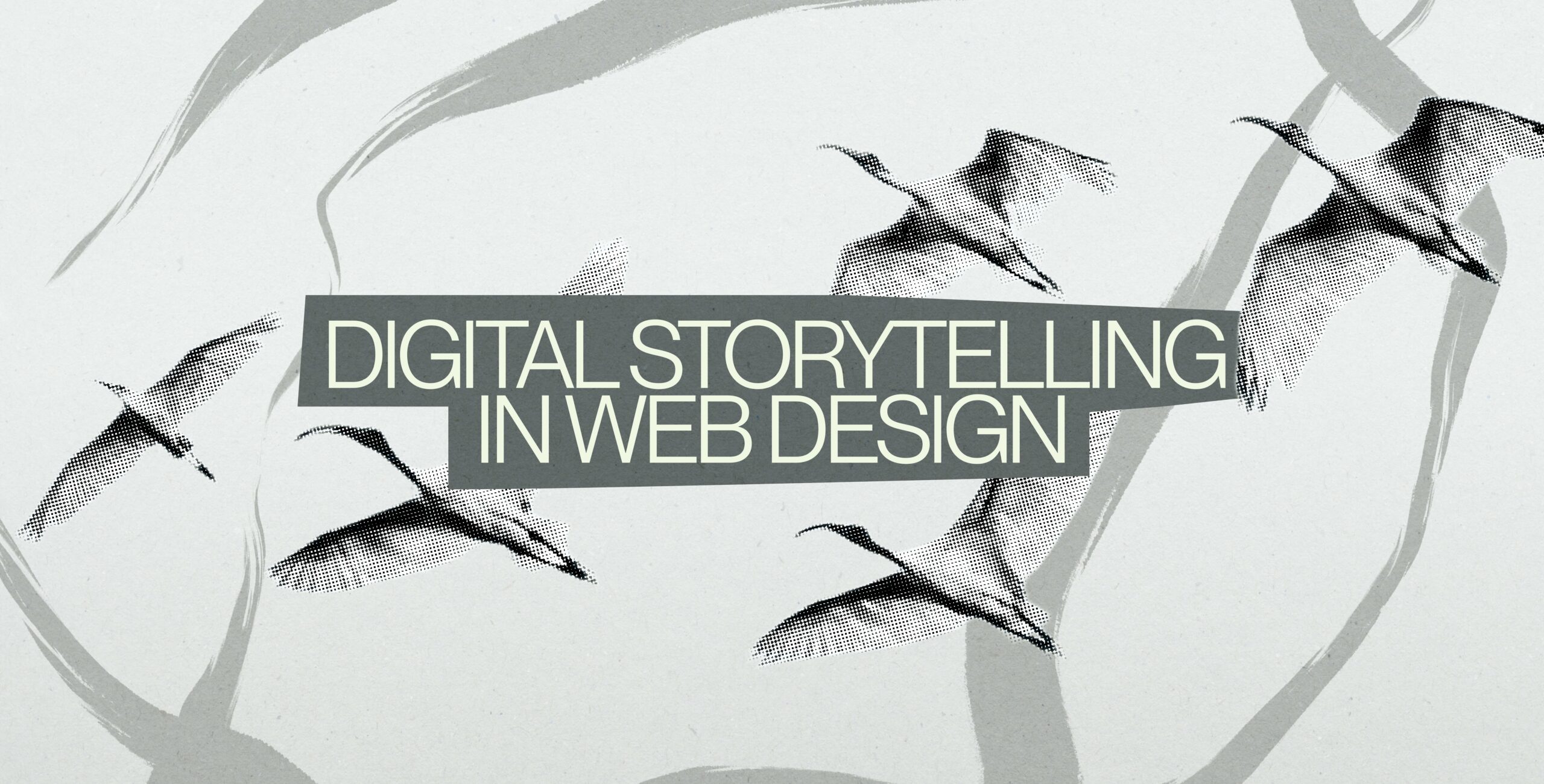Outline:
Modern web design moves beyond static web pages into realms where immersive experiences captivate audience attention like never before. The art of storytelling in web design stands at the leading edge of this transformation, offering a dynamic medium through which brands can weave compelling narratives.
These narratives are more than just digital stories. They are strategic tools designed to connect, inform, and inspire step in and take action. With a balanced combo of visual features, interactive elements, and personalized content, digital storytelling gives a brand the potential to transport users into its world, making the message not just heard but experienced.
The Transformative Power of Digital Storytelling: Benefits & Impact
As we delve into the significance of visual storytelling for brands, we must recognize its power to break through traditional conventions. It opens up a variety of opportunities for companies thriving to get the most of public attention and involvement in the cluttered market.
In essence, the strategic use of digital stories in web designing tackles common challenges of competitive customers acquisition and also capitalizes on the following:
Immersive Experience
Deeply engaging user experience is a hallmark of effective web design storytelling. By integrating visuals and interactive features, your digital narrative can entice users, encouraging them to feel as active participants of the story. This way of interaction boosts engagements, extending the time users spend on the website and reduces bounce rates.
Emotional Connection
Incorporating storytelling, a website can cultivate feelings of empathy, excitement, or curiosity, turning passive visitors into engaged participants. This emotional bonding is vital for establishing trust and loyalty.
Conveying shared values and experiences in the story can result in a stronger, more personal connection between customers and brand, fostering a sense of community and belonging.
Memorable Brand Identity
Digital storytelling has a strong impact on brand identity. Unconventional designs can help to set a brand apart from competition and translate its unique personality and voice right to the users hearts and minds.
It not only makes the brand’s narrative unforgettable and distinct but also simplifies the delivery of complex brand ethos or concepts, transforming them into digestible, relatable content. Consequently, web storytelling shapes a more approachable and understandable branding image.
Higher Conversion Rates
By using immersive visuals and narratives in web design, brands can more effectively captivate customers, increasing their retention and conversion rates as visitors are more likely to take an action after being emotionally connected.
Naturally Understood Visual Language
Digital storytelling may serve as a universal language that crosses cultural and linguistic boundaries, making it an effective communication tool for global audiences, ensuring your messaging is always at the forefront regardless of customer context.
Fundamental Web Design Components of Digital Stories
The impact of digital storytelling in web design significantly relies heavily on the thoughtful selection and harmonious balance of various media elements. Let’s delve into the key components:
- Imagery and Visuals
Selecting the right images is important as they set the scene for the whole narrative. Visual storytelling is built upon high-quality pictures, illustrations, and video content that carry emotions and transmit messages. Visuals aid in directing the audience along the narrative, creating the desired story flow and contributing to the specific mood.
- Typography
Typography here means more than choosing fonts; it’s about creating an atmosphere. Choosing the right font, size, and spacing to raise specific feelings, and reflect the story’s tone is central. Whether seeking to inspire excitement or convey elegance, the typography should work in tandem with the narrative, guiding the reader’s eye and highlighting important messages.
- Color and Mood
Colors play a vital role in web design, each carrying emotional significance. Designers use color palettes that elevate the narrative, setting the story’s mood and defining the user’s emotional response throughout their journey.
- Layout and Flow
A well-designed layout provides easy and effortless navigation, developing a natural flow from one block to another. This arrangement should be based on logic and lead visitors through a coherent scrolling adventure, making the digital experience uncomplicated and smooth.
- Interactivity
In contrast to static content, digital stories embrace interactivity, which encourages deeper connection. Micro-interactions impact the line of the story, while thoughtful animations add depth and emotional resonance. Together, they invite users into an active exploration, making the experience dynamic, interactive and memorable.
How to Frame Storytelling in Web Design: Structuring Web Narratives
To make your digital story coherent and cohesive and keep the messaging clear, it’s important to follow a thoughtful structure. A balanced story architecture would involve three parts: a clear beginning, midpoint, and wrapping up.
Hook
It’s where you grab the audience’s attention and set the tone for what’s to come, inviting them to explore more. The hook can be an eye-catchy visual, a bold headline, a captivating animation, or their combinations to make up an entry point to your digital narrative.
Midpoint
This is where the bulk of your story unfolds. Here, the layout and interactivity become particularly prominent. The layout should guide the viewer through the different stages of the narrative in a logical and alluring manner. Use interactive elements to enrich the narrative, which helps users to delve deeper into the content, and make their experience even more immersive.
Wrapping up
The ending of your narrative should help you to drive the message home and encourage the audience to take action, whether that’s contacting your company, ordering your service, or simply reflecting on the ideas. The wrapping up should provide a clear understanding of the narrative’s purpose and messaging.
Best Practices in Digital Storytelling
Once you understand which elements to include and how to craft your digital story for bigger impact, let’s dive into the best practices for digital storytelling.
Use Multiple Media Types
While visuals and text are basic narrative elements, consider complementing your storytelling by a variety of media types such as images, photos, videos, text, infographics, or animations. It will not only add depth to your story but also fit different audience preferences and comprehension levels.
The website Think.Speak.Transform is the epitome of how to leverage immersive animations and innovative storytelling techniques to engage users deeply. It frames challenges immediately followed by solutions and poses questions with ready answers. This approach captivates attention through visual storytelling and communicates the company’s value proposition effectively, guiding visitors through a journey that highlights the impact of their offerings.
Utilize Media Wisely
Visual elements are fundamental to web design storytelling. They should help in forming a consistent flow and creating impact. Apply high-quality images and video footage that associate with your branding. Avoid stock images or videos since they damage credibility and trust. Be mindful of the pacing and ensure that visuals are synchronized with the text and audio.
A great example of visual storytelling is Alaris Acquisitions, as it employs a timeline to guide users through the process of how they work. This method outlines each step of their service in a clear, chronological order, making complex information more digestible.
Emphasize Emotion
Emotional content makes your story more compelling and memorable. Think about the emotions you want to instill in your audience and how each element of your story contributes to it.
Personalize Your Narrative
Web storytelling in web design can be bolstered by data-driven personalization. By learning user data, brands can adapt their storytelling strategies to mirror the audience’s specific interests and needs. This customization transforms the narrative into a personalized journey.
Being an illustration of this practice, Dot by New Computer excels in visual storytelling through a centered layout that emphasizes simplicity and clarity, enhancing the user’s focus on content. Generous whitespace around elements creates a clean, uncluttered interface, improving readability.
Embrace a Specific Style
Maintaining a consistent style throughout your digital story is paramount. It includes the use of well-matched colors, specific fonts, transitions, and pacing. A consistent style creates a holistic professional-looking narrative that is easy to comprehend and remember.
Keep the story Concise
Given short attention spans, consider your digital story lengths and ensure it is short enough to raise engagement. A typical story lasts between 2 to 5 minutes. Keeping it concise helps to keep the users’ attention on point and ensures that your message will be heard and experienced.
One of excellent examples of implementing this practice is Browley&Co, which effectively combines photographs of artwork and quotes within a smoothly animated layout. This design choice creates an engaging visual experience that draws visitors deeper into the world of the artist, showcasing the artworks in a dynamic and interactive context that complements the visual narrative of the site.
Integrate Calls to Action
If your story aims to inspire, inform, or persuade, integrate a clear call to action. Tell your audience what you hope they will think, feel, or do after experiencing your story.
Prioritize Accessibility
Ensure that your digital story is accessible to people with disabilities. This can involve adding captions for an audio, using text descriptions for images, and ensuring your content is navigable for those using screen readers.
Stay Up-to-Date with Technology
Digital storytelling tools and platforms are constantly evolving. Stay informed about new tools, trends, and best practices in web design storytelling so you can continually improve your skills and refine your stories.
As an instance of using new technologies, the Amie website showcases captivating scroll-triggered animations that effectively grab the user’s attention. These animations provide a dynamic and interactive way to present information, making the exploration of product features an engaging experience.
Storytelling in Web Design Challenges
While digital storytelling has the potential to impact engagement and user experience dramatically, several challenges and pitfalls may hinder its effectiveness. To create a compelling and successful narrative, you should recognize these issues and avoid them.
Overcomplicating the Story
Adding too many elements or plot points, making the story confusing or overwhelming for the user is a big mistake. Solution: Keep the narrative focused and straightforward. Ensure every component adds value and advances the story.
Ignoring User Experience
A story might be compelling, but if the user experience is poor, your audience will disengage. Solution: Prioritize navigation, optimize for faster loading times, and mobile responsiveness. The user’s journey through your story should be seamless and intuitive.
Lack of Engagement
If the story does not resonate or connect with the audience, it will fail to hold their attention. Solution: Understand your audience’s needs and interests. Craft your story to reflect these aspects and integrate interactive elements to foster engagement.
Not Utilizing Data and Feedback
Failing to measure the effectiveness of your narrative can lead to missed opportunities for improvement. Solution: Incorporate analytics and track user engagement, gathering feedback. Based on the results, refine and improve your storytelling approach for better impact.
On a Final Note
Ultimately, the stories we tell define us; make yours count. At the heart of every effective digital story is a clear, focused narrative that connects with the audience and evokes emotions. Whether you’re looking to simplify complex information, showcase your brand’s unique personality, or increase conversions, a well-crafted digital story can be your helpful tool.The power of good storytelling is immense — harness it to transform your brand image, engage your audience, and achieve your business goals. If you want more insight, or need help in crafting an impactful digital story, feel free to contact us. We’re here to help.





